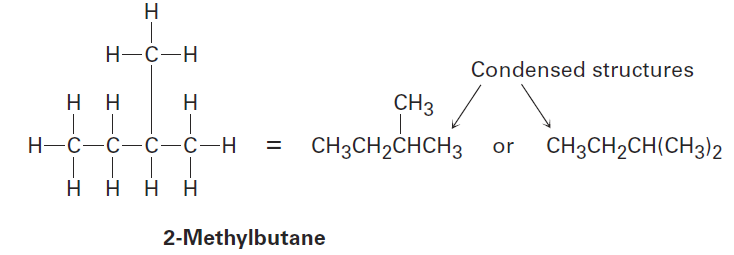
Drawing Chemical Structures
 المؤلف:
John McMurry
المؤلف:
John McMurry
 المصدر:
Organic Chemistry
المصدر:
Organic Chemistry
 الجزء والصفحة:
9Th. p22
الجزء والصفحة:
9Th. p22
 7-2-2016
7-2-2016
 2645
2645
Drawing Chemical Structures
In the structures we’ve been drawing until now, a line between atoms has represented the two electrons in a covalent bond. Drawing every bond and every atom is tedious, however, so chemists have devised several shorthand ways for writing structures. In condensed structures, carbon–hydrogen and carbon– carbon single bonds aren’t shown; instead, they’re understood. If a carbon has three hydrogens bonded to it, we write CH3; if a carbon has two hydrogens bonded to it, we write CH2; and so on. The compound called 2-methylbutane, for example, is written as follows:

Notice that the horizontal bonds between carbons aren’t shown in condensed structures the CH3, CH2, and CH units are simply placed next to each other but the vertical carbon–carbon bond in the first of the condensed structures drawn above is shown for clarity. Also, notice that in the second of the condensed structures the two CH3 units attached to the CH carbon are grouped together as (CH3)2.
Even simpler than condensed structures are skeletal structures such as those shown in Table 1-3. The rules for drawing skeletal structures are straightforward.
Rule 1
Carbon atoms aren’t usually shown. Instead, a carbon atom is assumed to be at each intersection of two lines (bonds) and at the end of each line. Occasionally, a carbon atom might be indicated for emphasis or clarity.
Rule 2
Hydrogen atoms bonded to carbon aren’t shown. Because carbon always has a valence of 4, we mentally supply the correct number of hydrogen atoms for each carbon.
Rule 3
Atoms other than carbon and hydrogen are shown.
One further comment: although such groupings as –CH3, –OH, and –NH2 are usually written with the C, O, or N atom first and the H atom second, the order of writing is sometimes inverted to H3C– , HO– , and H2N– if needed to make the bonding connections in a molecule clearer. Larger units such as –CH2CH3 are not inverted, though; we don’t write H3CH2C– because it would be confusing. There are, however, no well-defined rules that cover all cases; it’s largely a matter of preference.


 الاكثر قراءة في مواضيع عامة في الكيمياء العضوية
الاكثر قراءة في مواضيع عامة في الكيمياء العضوية
 اخر الاخبار
اخر الاخبار
اخبار العتبة العباسية المقدسة


